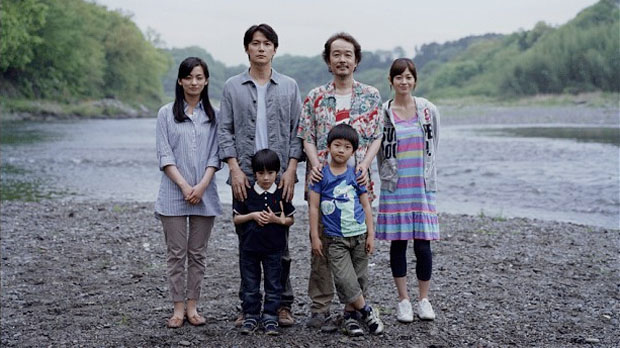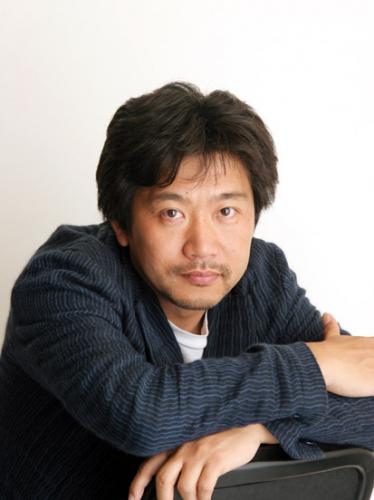 Back to selection
Back to selection
Hirokazu Kore-eda on Crafting Shots and Scouting Locations for Like Father, Like Son
 Like Father, Like Son
Like Father, Like Son Hirokazu Kore-eda is a wanderer. The Japanese director, 51, has been known to disappear on set, leaving his cast and crew wondering where their maestro’s ventured off to. For instance, while making his 2008 masterpiece, Still Walking, Kore-eda vanished for a spell, only to discover the flowering trees that became an invaluable motif in the film. The director’s exploratory nature, which one might partly attribute to his background as a documentarian, has proven crucial in the poetic meticulousness of his exteriors. However, his visual instincts are hardly outdoor-exclusive, and his keenness for selecting ideal settings and compositions is just as present in his interior shots.
Kore-eda’s latest film, Like Father, Like Son, concerns a switched-at-birth scenario wherein two couples, the upright Ryota and Midori Nonoyima (Masaharu Fukuyama and Machiko Ono) and the laid-back Yudai and Yukari Saiki (Lily Franky and Yoko Maki), discover they’ve been raising each other’s six-year-old sons, the reserved Keita (Keita Ninomiya) and the aloof Ryusei (Hwang Sho-gen). Nature versus nurture is explored through tender melodrama, and, true to form, Kore-eda presents a wellspring of eye-catching frames and locales, each of them inviting their own thematic readings. Visiting Manhattan when Like Father, Like Son played at last year’s New York Film Festival (it opens in limited release today), the director shared with Filmmaker some anecdotes and inspirations behind the film’s most memorable shots, and discussed where that wide-eyed curiosity led him this time.
Filmmaker: In Like Father, Like Son, the first image that stood out for me was the spiral staircase at Keita’s school, and soon after, there’s another overhead shot of the Nonomiya family on a staircase. Can you discuss where and how you found these staircases, and how they supported the metaphor of what this family is spiraling into?
Kore-eda: For the first scene, where they’re taking the interview at the elementary school for the son, that spiral staircase I actually stumbled upon, and I immediately thought, “This is what I want to take [from this location].” So that’s why it ended up in the film. There are a lot of stairs in the first half, with the family going up and down. There are also a lot of elevators shown with the main character, Ryota, going up and down. I don’t know if that part has a particular meaning or not! The second staircase you mentioned was in the law office, when the family was reading the results of the DNA testing, and I had them going up [rather than down] in that case. In terms of the theme for the movie, I tried to take a lot of different line shots, as well as give the sense of a whirlpool with the spiral image. That was something I consciously incorporated.

Filmmaker: I also wanted to ask about the apartment building where the Nonomiya family lives. We’re presented a lot of exterior shots of Ryota entering the building after work, and it’s one of the more interesting settings that highlight the film’s attention to architecture. Can you discuss why or how you chose that building?
Kore-eda: In terms of the high-rise that I picked, I was really looking to contrast the two families. So regarding the building that I was looking for for Ryota’s family, I wanted to make it a house that’s not liveable — it didn’t look like a house where someone would live. They were separated from the ground floor, no one visited them they had no family or friends. It was just them — the core, nuclear family. So that was why I picked that type of building.
Filmmaker: Within the apartment itself, there’s also the beautiful recurring image of city lights captured in reflection, during nighttime shots in which the family plays together. The shots look almost dreamlike. How did you achieve that?
Kore-eda: It’s simply a reflection from the city lights. In the camping scene that occurs later in the film, they’re talking about shooting stars, so I wanted to have the city lights reflecting as if they were shooting stars. But I didn’t add light to create that image. Of course I strove to create that reflection, but I didn’t add any additional effects or anything like that. I really valued that space’s light.
Filmmaker: I think my favorite shot of the film is the one in which the two boys’ photos are next to each other on a coffee table, but one is inverted, so they’re facing in opposite directions. It’s a shot that could encapsulate the film. Was this an image you always had in mind while storyboarding, or did it come about organically during the process?
Kore-eda: That was something that was in the script, and that I had previously arranged, in terms of the shot. I thought it was an image that was very easy to understand, and that the audience could connect to — and for me, it was a very important shot.
Filmmaker: Were there a lot of images like that? Key shots that, walking in, you had already mapped out in your mind, and that you knew you wanted to include so as to encapsulate the story in a similar way?
Kore-eda: There were some. In terms of exchanging the children, there was a lot of going back and forth in the car, so you’d see this image of the black car, and in the background have the trains and the power lines as well. So that was something else I had from the beginning as an image that I wanted to convey — this idea of transference. But I actually try not to have those kind of images. It’s more like, while I’m filming, I’ll look for the appropriate scenery, or the movement of people, so I sort of discover as I go. But in the case of the power lines, that was something I really wanted to have, so I instructed my staff to look for that sort of image.
Filmmaker: We also get some detailed shots of food in this movie, which I’ve appreciated in your work ever since Still Walking, which is very food-centric. Here, we have such images as the overhead view of the meat frying in the Nonomiyas’ kitchen. Is there any significance to the food you chose to include? Perhaps in relation to how the story itself resonates personally?
Kore-eda: I don’t know how much personal experience played into that. I mean, I do like Sukiyaki, which they’re making during the meat scenes, but I don’t know if that was really the point. The point was it was a very expensive, high-quality meat, and you could see that by looking at it. This was intended as a contrast with the other [poorer] family, who were eating dumplings. So, again, creating a gap between these two families was what I was looking to do. My personal experiences were more closely related to Still Walking, where the food really did reflect what I’d actually eaten in my own life.
Filmmaker: And the restaurant in which the two couples are sitting, following a trial regarding their sons — that’s one scene in which you seem to plainly illustrate the juxtaposition of lifestyle, or class, between the families. Yudai Saiki is eating somewhat sloppily, and his wife is smoking, while the Nonomiyas remain still and composed. How did you come upon that restaurant?
Kore-eda: It’s actually more of a casual coffee shop. I forget a lot of the details, but I know that you don’t really see places that have that kind of appearance anymore. A lot of places have become more generic, Starbucks-type coffee shops. But this place really had something that was very reminiscent of the Showa period in Japan, where you can sit in the back, and you can see the door. So there’s a contrast between the back and the front, and when I was making the vertical composition, I wanted you to be able to see the entrance clearly. But in terms of the two couples, I think it was less about emphasizing the differences between the couples themselves than it was about showing the dynamic of the four people. Earlier in the film, it had sort of been two against two, then in this scene the dynamic shifts to almost show them as three against one, with Ryota almost being scolded. And about the food, it was actually cinnamon toast with ice cream. And normally you’d think this is not something one eats after a trial, but of course [Yudai] is eating it, and [the shot] is a bit criticizing. I think that’s the image I wanted to create there.
Filmmaker: There’s a scene by a river where a group photo is taken, and within that scene is another memorable shot in which Ryota and Keita stand in front of a boulder. A creek flows between them and the boulder, and it’s as if you’re literally depicting movement between a rock and a hard place. Can you describe the circumstances of setting up that scene and that shot?
Kore-eda: Ah, the scene before they take the photo. It’s a good shot. [Laughs] I don’t know, really. You had the boulder, which I thought was perfect, as well as the flowing river, and I liked the variations in the flow. So simply I felt that would be the perfect background for a scene that I thought would have a lot of impact.
Filmmaker: And then finally, we have the climactic scene with the two paths by the river, where Ryota is apologizing, and Keita is placed on slightly higher ground, and they finally meet. How did you stumble upon that place, and when did you know it was where you wanted to cap off the film?
Kore-eda: That’s in [the Japanese city of] Maebashi. I did use my walking-around method when I found the two parallel streets by the river. I was looking for a place that would have that sort of layout, and just I happened to find this. So when I saw it I thought, “Yes. I’d like to shoot the climax there.” Again, it just came from me walking around.
